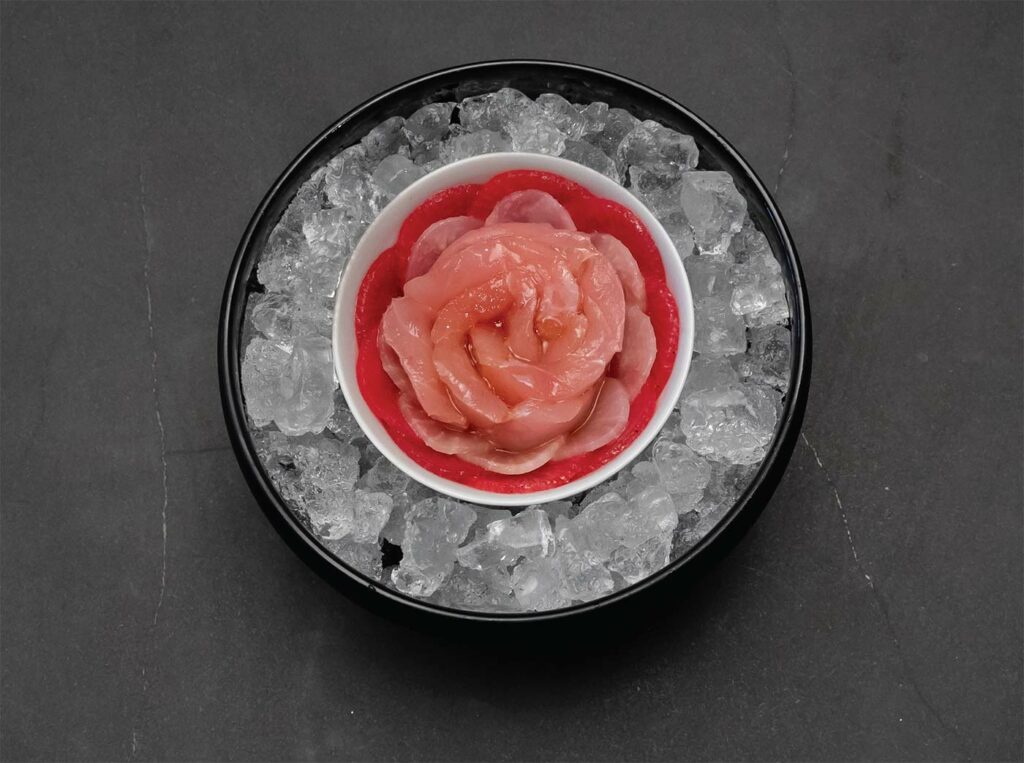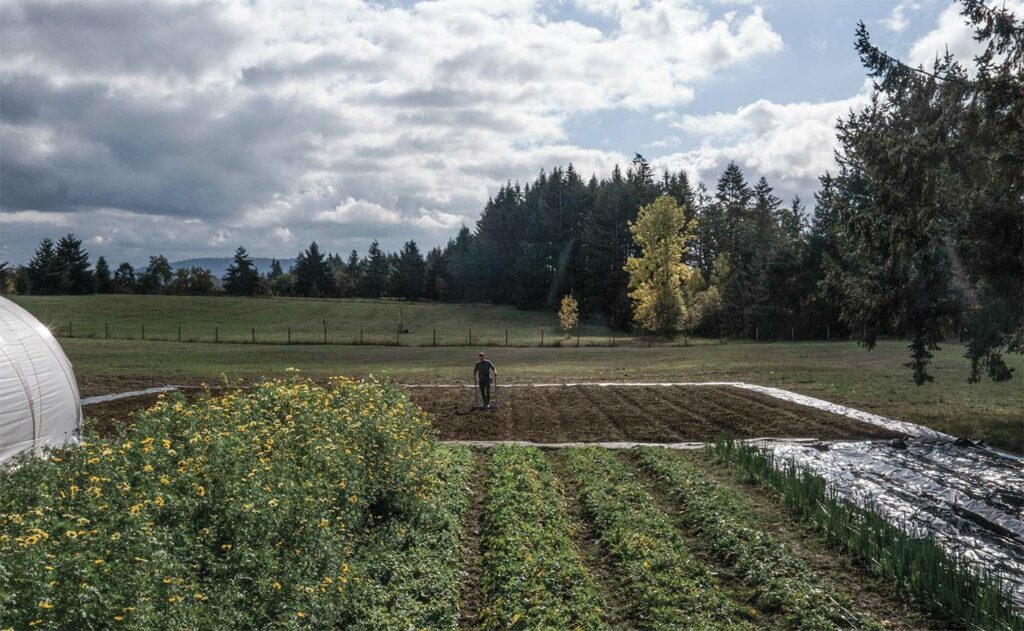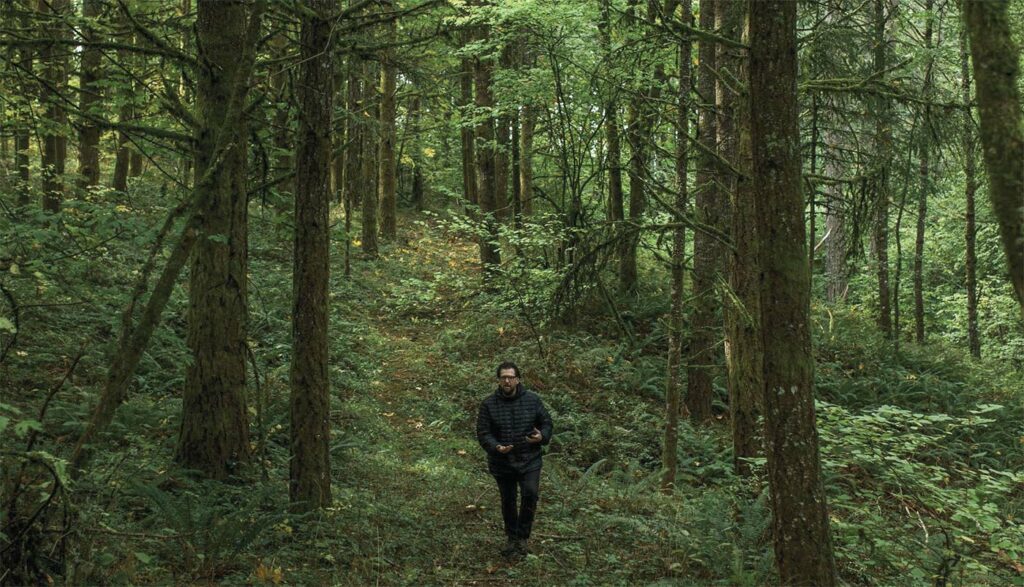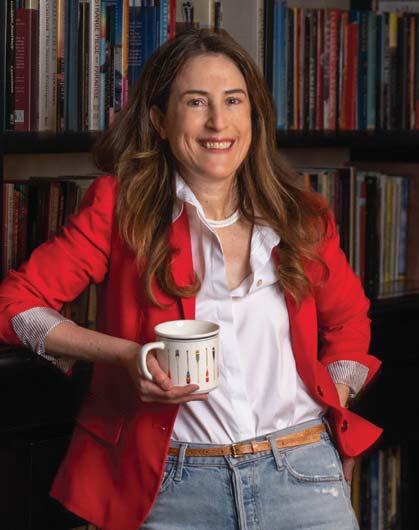
Farming and Fermentation Go Hand In Hand at ōkta
It’s easy to dream at ōkta Farm. A 70-acre sea of green surrounded by vineyards and century-old fir and cedar trees. Depending on the season, you can spy salt and pepper-speckled sheep grazing in the vineyard or a fresh crop of Pinot Noir-hued King Stropharia mushrooms—commonly known as wine caps for their deep burgundy color. “We also grow oysters and shiitakes,” says Farm Manager Saruh Wynes, who tends to over 90 varieties of vegetables, fruits and herbs on a one-acre plot.
On this early spring day, she’s cheerfully seeding plants in one of two hoop-style greenhouses, eager for the first spring greens to pop. She points to a row of microgreens that includes salad burnet, a member of the rose family notable for its frilly leaves that evoke a subtle cucumber flavor. Also on deck, strawberry spinach, arrow-shaped greens that burst with clusters of bright red berries. This variety is on a list Wynes calls “looks fun, let’s trial it.” She’s always on the hunt for rare plants that erupt with taste, texture and beauty.
“For other early crops, we have a tricolor of beautiful spring peas, some favas and multiple varieties of heirloom beans like this black turtle bean.” She hands one over for luck. To say Wynes works closely with the culinary team at ōkta would be an understatement. A typical day for Executive Chef Matthew Lightner starts with a walk around the wine country farm—located about 10 miles away from the downtown McMinnville restaurant. That’s when he and Wynes taste the present and plan for the future.
The celebrated restaurant opened in the summer of 2022, a vision Lightner shared with partners Katie Jackson and Shaun Kajiwara of Jackson Family Wines. About 10 years ago, the couple purchased an old cherry orchard on the western side of Ribbon Ridge and planted what is now Bramble Hill Vineyard with the future goal of integrating a working farm and restaurant and hotel. (A familiar model associated with many of Europe’s countryside Michelin star restaurants).
That time is now—and in the summer months, nearly all of the produce for ōkta’s wildly imaginative 10–15 course tasting menu arrives freshly harvested from this idyllic farm. Think umami-packed dishes like blue curry squash feathered around a dome of grilled caviar or peppercorn-crusted venison with Ozette potatoes cooked in brown butter miso (the heirloom potato was traditionally grown by Pacific Northwest tribes).


THE FERMENTATION WIZARD
But what truly sets ōkta apart is the magic that happens in an airy garage just steps away from the meticulous rows of vegetables and herbs. Head into this on-farm larder—a dedicated preservation and fermentation lab—and you’ll meet Larry Nguyen, the dynamic larder chef who has cooked worldwide, including a stint at Denmark’s groundbreaking Noma. Now, he’s the essential conduit between ōkta’s farm and restaurant, brainstorming ways to increase the longevity of their produce through each micro-season while also sparking an edgeof- the-seat fermentation revolution.
Surrounded by jigsaw stacks of bottles and jars and buckets, his handwritten labels read like a thrilling choose-your-own-adventure book (one for fermentation geeks). There’s black futsu tamari (a deep savory sauce made from fire-roasted heirloom squash and purple barley) and quince amazake (a sweet sake). Geoduck garum (fish sauce) and pumpkin bushi. The latter is dried, smoked and fermented pumpkin, another umami boost for dishes. “We are doing every type of preservation you can imagine here,” says Nguyen, who dreams of wildly inventive ways to transform local produce using both ancient and modern fermentation techniques. “One of the more unique things we have going is all our Japanese-style ferments from miso to shoyu production.”
For Nguyen, his work often starts with one question: What can I do to maximize the use of this vegetable or fruit from the farm? He turns to a prized heirloom pepper as his first example. “The Jimmy Nardello is a real staple for this restaurant,” he says. “I mean, everyone loves a good Jimmy.” His creative spins range from juicing the pepper, mixing it with miso and turning it into a tamari sauce; pickling the long thin peppers to punch up a relish; and even making his own sweet paprika from leftover pepper solids.
“If I can preserve something, if I can give it that second life, a second run around on the menu, that is something special,” says Nguyen. His passion for food preservation, fermentation and a zero-waste kitchen is clear, especially when he rolls out a tasting board sprinkled with his current experiments. At the top is a Taiwanesestyle fermented kale (usually made with bok choy). Bright, tangy and brisk.
Next, golden slivers of turmeric fermented daikon—crunchy, earthy and peppery. “It’s from last year when Saruh came in with a bunch of daikon that had mold damage,” says Nguyen. He’d been curious about making a Japanesestyle pickled daikon and this presented the opportunity. “I get to make all these fun and creative flavors and ingredients,” he says, “while also finding new ways to increase the usage of our trim or waste.”
Last year, he made a strawberry kombucha for a collaboration with Salt & Straw Ice Cream. But he evaporated off the water to enhance the fresh strawberry flavor. It still tastes like peak summer. “When I describe fermentation, I compare it to farming,” says Nguyen. “I create the environment for the bacterium to grow. I can nudge it left, I can nudge it right. But at the end of the day, I’m still beholden to the great Mother Nature.”
One of Nguyen’s favorite seasons is spring when pale pink blossoms flutter on the sole cherry tree just outside the larder. “It usually lasts for one week. I collect as many flowers as I can and I use that in several ferments,” he says. He makes cherry oil from the branches and salts the sakura leaves. “All of the ingredients from that one moment are interconnected.”

SENSE OF PLACE THROUGH FOOD
At ōkta restaurant, these connections to the farm and larder are highlighted throughout the evening. It starts with a written reflection of the season by chef Lightner along with a beautiful watercolor in soft pastels by artist Mia Nolting. The card at a recent dinner began with the lines: “As the sky peeks through deep-hued clouds, the fog rolls over the hills of fresh-sprouting grass like a blanket.”
Other cards served like an intermezzo throughout the evening included a whimsical illustration of the farmed, foraged and fished ingredients from the menu, a map of the surrounding microclimates and a comprehensive index of Larry’s ingenious larder creations. Think 18-month-aged shoyu made with oak fire-kissed Ayers Creek freekah and black tepary beans. Or an earthy tamari sauce made from fire-roasted black futsu squash and purple barley.
It’s a reminder of how Ligtner and his team are reimagining what farm-to-table can be. “The farm and the larder become the pantry,” says Lightner, “with so many elements and no limitations.” For Lightner, a recent James Beard semi-finalist and Michelin-starred chef, each dish is an opportunity to evoke a sense of place—a deeper connection to the surrounding soil and sea and rivers. He describes this as “cooking of the mood and the moment.”
At a recent dinner that starred dishes like divercaught sea urchin in a creamy quince amazake, coral pumpkin slices circling the briny uni like sunflower petals. It was followed by sweet purple kyoto carrots, checkered across a caramelized farro waffle with parsnip miso from the larder. Every dish spoke to a story of ingredients that started on the farm, moved through a poetic transformation in the larder and then turned into an epiphany on the plate. Each bite was proof that sometimes there’s no better way to capture the fleeting passage of time than through food.

